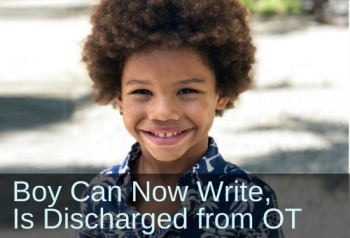Boy with ADHD Symptoms Gains Emotional Regulation, Focus, Great Improvements at School
Submitted by Lisa Van Heukelom, OTR/L

|
Before
|
After
|
|
Dificulties with pencil grasp, expressing ideas through writing, and copying words from the board.
|
Able to think of a topic to write about and produce at least four sentences with correct word spacing, spelling, and no letter reversals.
|
|
Difficulties sitting still and following directions.
|
Able to sit and attend to lessons in his class.
|
|
Big emotional outbursts toward sister and bus-mates
|
Emotional regulation has improved; calmer at home and at school.
|
|
Started occupational therapy in February 2018, with little to no results for the first 7 months of treatment.
|
Saw posiive changes after starting rhythmic movements and reflex integration; has met all OT goals, and will be discharged from OT
|
Bentley is a 7 year old boy who is in second grade. Bentley first came to me for an initial occupational therapy evaluation in February 2018 for ADHD symptoms that included difficulty sitting still and following directions, self-regulation that included big emotional outbursts towards his sister and peers on the bus and handwriting difficulties. Bentley’s handwriting difficulties included poor pencil grasp, difficulty expressing ideas through writing and difficulty copying words from the board. I began working with Bentley one time a week for one hour sessions each time. After the initial evaluation I preceded with traditional occupational therapy interventions such as Zones of Regulation program to address his difficulty with transitions and emotional regulation, repetitive practice for handwriting/letter formation and proprioceptive and vestibular input to address attention to task with little to no results for our first 7 months of treatment. After taking the Brain and Sensory Foundations class I decided that I needed to switch up my approach with Bentley as I believed he had unitegrated primitive reflexes hindering his progress in OT sessions.
The session prior to starting reflex integration Bentley came to me with extremely high energy and inability to focus. I started the session with 15 minutes of the rhythmic movements which he tolerated very well. After the rhythmic movements [from the Brain and Sensory Foundations course] Bentley was able to focus and follow directions so, I proceeded to check his primitive reflexes and noticed the following reflexes were unitegrated: ATNR, and his Hand Reflexes.
The first session of incorporating reflex integration begins with 10 minutes of rhythmic movements. Bentley again tolerates these movements very well and I notice a great decrease in his hyperactivity. After the movements I have Bentley riding a roller racer in which he has to coordination bilateral upper and lower extremities in order to propel the bike. The roller racer also incorporated some nice midline crossing. During this activity Bentley displayed difficulties with coordinating upper and lower extremities and the midline crossing. After a couple passes Bentley was displaying some fatigue so we moved onto ATNR integration after stimulating the reflex. Bentley tolerated the integration activities fairly well this first initial session. After integration of ATNR Bentley moves onto vestibular input through a game of basket ball on a bolster swing.
After swinging, I work on integrating Hand Reflexes [from the Brain and Sensory Foundations course] in preparation for our writing activity. First I stimulate the Hand Grasp reflex then had Bentley complete the sequence of grasp hand positions 3 times.
During two of our recent sessions I had Bentley complete the 5-Step Balance Process [from the Brain and Sensory Foundations course]. During each of the sessions Bentley and I came up with a goal to produce four legible sentences of any topic of his choice with minimal difficulty. I had Bentley physically act out the process of writing first, and then we moved onto ATNR, STNR, and Hand Reflex integration along with rhythmic movements. After reflex integration Bentley would perform Hook-ups or Cross Crawls with eyes looking in all directions. After competing this step I would have Bentley chose his topic and write out his four sentence. On both occasions of completing the 5-Step Balance Process Bentley was able to think of a topic to write about and produce at least four sentences with correct word spacing, spelling and no letter reversals!
In addition to what I have been doing in my session with Bentley, his mother completes the rhythmic movements with him almost every day and prior to writing activities Bentley will independently complete the sequence of grasp hand positions.
Since starting the reflex integration activities [from the Brain and Sensory Foundations course] with Bentley, his mother states that he is calmer at home and at school. He is able to sit and attend to lessons in his class and his state of emotional regulation has improved. Mother states that Bentley is able to tolerate change without emotional outburst and is getting along with his sister and peers much better. Mother states that Bentley has also made great improvements at school with his handwriting legibility, reading and getting his thoughts onto paper.
Since going from traditional occupational therapy approaches and making minimal gains, to more of a reflex integration approach to Bentley’s treatment plan he has met almost all of his OT goals. Bentley will be discharging from occupational therapy within the next couple of weeks thanks to the rhythmic movements and reflex integration.
[Edited, emphasis added]


